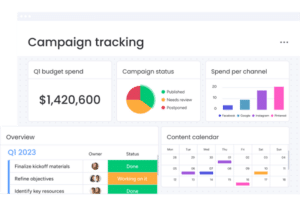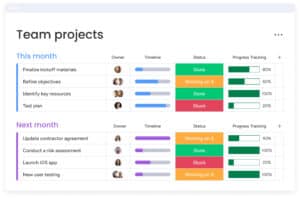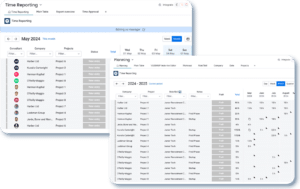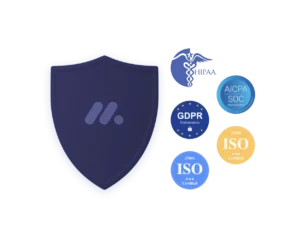Introduction
Understanding the Landscape of Hybrid Project Management
In the evolving world of project management, the shift towards a hybrid model has become increasingly prominent. Hybrid project management, a blend of traditional and agile methodologies, offers a versatile approach to tackling diverse project demands. However, this blend brings its own set of challenges that can perplex even the most experienced project managers. In this comprehensive guide, we delve into the core of overcoming common challenges in hybrid project management, offering insights and strategies to navigate this complex terrain effectively.
The Significance of Hybrid Project Management in Today’s Business Environment
Hybrid project management has emerged as a response to the rapidly changing business landscape, where the rigidity of traditional methods meets the flexibility of agile practices. It’s a realm where structure and adaptability coexist, aiming to leverage the strengths of both worlds. But, as enticing as it sounds, integrating these methodologies is often fraught with challenges. From communication barriers and team dynamics to technological integration and stakeholder alignment, the hurdles are diverse and multifaceted.
In this blog post, we will explore these challenges in detail, providing practical solutions and real-world examples to help you master the art of hybrid project management. Whether you’re a seasoned project manager or new to the field, this guide is designed to equip you with the knowledge and tools necessary to thrive in this hybrid era.
Understanding Hybrid Project Management
Defining the Hybrid Approach in Project Management
Hybrid project management is an innovative approach, blending the predictability of traditional project management methodologies with the flexibility and adaptability of agile practices. This fusion aims to create a balanced framework that can navigate the complexities of modern projects, where requirements often change, and stakeholder engagement is crucial. In overcoming common challenges in hybrid project management, understanding its foundational principles is key. This approach does not favour one methodology over another; instead, it harmonizes them to suit the unique demands of each project.
Traditional vs. Agile vs. Hybrid: A Comparative Overview
To appreciate the essence of hybrid project management, it’s crucial to understand how it differs from its traditional and agile counterparts. Traditional project management is often characterized by a linear, sequential approach, emphasizing detailed upfront planning, rigid structures, and a clear, unchanging path to project completion. On the other hand, agile project management thrives on flexibility, iterative processes, and continuous feedback, making it ideal for projects with evolving requirements.
Hybrid project management emerges as a solution bridging these two worlds. It adapts to the changing landscape of project requirements, integrating the stability of traditional methods with the dynamism of agile practices. This integration addresses many challenges, such as managing complex projects with both fixed elements and evolving components.
Benefits of Adopting a Hybrid Model in Project Management
Embracing a hybrid approach in project management comes with numerous advantages. It allows teams to be more responsive to change while maintaining a sense of structure and direction. This adaptability is particularly beneficial in overcoming common challenges in hybrid project management, such as dealing with diverse stakeholder expectations or navigating projects with both fixed and variable elements. Moreover, the hybrid model fosters a collaborative environment, encouraging team members to contribute their best regardless of their preferred methodology. It’s a testament to the saying, “The whole is greater than the sum of its parts,” where the combined strengths of traditional and agile methodologies yield a more robust, flexible, and efficient project management approach.
Maintaining Communication and Collaboration
The Critical Role of Communication in Hybrid Project Management
In the realm of hybrid project management, maintaining effective communication and collaboration stands as a pivotal challenge. This model, which merges traditional and agile methodologies, often leads to diverse team structures and varying communication styles. Overcoming common challenges in hybrid project management begins with recognizing the importance of streamlined communication across all levels of the project. The key is to establish a framework that accommodates different methodologies while fostering a unified language for project progress, expectations, and changes.
Strategies for Enhancing Communication in a Hybrid Environment
To mitigate communication challenges in a hybrid setting, it’s essential to implement strategies that bridge gaps between varied team dynamics and methodologies. One effective approach is the adoption of comprehensive project management tools that offer versatility and adaptability to different communication needs. These tools should support both the structured documentation required in traditional methods and the real-time collaboration favoured in agile practices.
Moreover, regular and structured meetings, such as daily stand-ups or weekly reviews, can serve as touchpoints for team members following different methodologies. These meetings provide opportunities for open dialogue, feedback, and alignment, ensuring that all team members are on the same page.
Fostering a Collaborative Culture in Hybrid Teams
Beyond tools and meetings, cultivating a collaborative culture is vital in overcoming common challenges in hybrid project management. This involves creating an environment where team members feel valued and empowered to share their ideas, regardless of their methodological preferences. Encouraging cross-methodology mentorship and knowledge sharing can also bridge the divide, allowing team members to learn from each other and appreciate different perspectives.
Creating opportunities for informal interactions, team-building activities, and open discussions about working styles can also enhance the sense of unity and collaboration. Remember, the goal is to build a cohesive team that leverages the strengths of both traditional and agile methodologies, turning diversity into an asset rather than a hurdle.
Omnitas Newsletter
Sign up for our monthly newsletter to stay up-to-date on our latest blog articles, videos and events!
Thank you!
You have successfully joined our subscriber list.
Balancing Flexibility and Structure
Finding the Middle Ground in Hybrid Project Management
One of the most significant hurdles in hybrid project management is striking the right balance between flexibility and structure. This balance is crucial for overcoming common challenges in hybrid project management, as it directly impacts the project’s ability to adapt to changes while maintaining a clear direction and timeline. The hybrid model demands a nuanced approach where the fluidity of agile methodologies and the stability of traditional practices coexist harmoniously.
Implementing Agile Flexibility within a Structured Framework
To address this challenge, project managers must adeptly navigate the nuances of both agile and traditional methodologies. This involves creating a structured framework that allows for agile flexibility. For instance, while maintaining a high-level plan consistent with traditional methods, it’s crucial to incorporate agile elements like sprints or iterative reviews. This approach enables teams to respond to changes rapidly without losing sight of the overall project goals and deadlines.
Tools and Techniques to Maintain this Balance
Utilizing the right tools and techniques is pivotal in maintaining the balance between flexibility and structure. Project management software that accommodates both Gantt charts (for structured planning) and Kanban boards (for agile task management) can be extremely beneficial. Additionally, adopting techniques like rolling wave planning, which allows for detailed planning in the near term while keeping longer-term plans more flexible, can be highly effective in hybrid environments.
Training and Mindset Shifts for Team Members
Equally important is training team members and encouraging a mindset shift towards embracing both methodologies’ strengths. Regular training sessions, workshops, and discussions about the benefits and challenges of both agile and traditional approaches can foster a more adaptable and versatile team. Encouraging team members to adopt a ‘hybrid mindset’ helps in overcoming common challenges in hybrid project management by promoting flexibility in thinking and execution.
Managing Team Dynamics and Morale
Navigating the Complexities of Team Dynamics in Hybrid Projects
In hybrid project management, a significant challenge lies in managing team dynamics and morale. This challenge is integral to overcoming common challenges in hybrid project management, as it impacts the effectiveness and well-being of the team. Hybrid projects often consist of team members with diverse backgrounds, skill sets, and preferences for either traditional or agile methodologies. This diversity, while a strength, can also lead to conflicts, misunderstandings, and varying levels of engagement.
Strategies for Building a Cohesive Hybrid Team
To effectively manage team dynamics in a hybrid environment, it’s essential to foster a sense of unity and understanding among team members. This can be achieved through team-building activities, regular open forums for discussing concerns, and celebrating successes together. Additionally, setting clear expectations and roles for each team member, while allowing room for flexibility, helps in creating a structured yet adaptable working environment.
Encouraging open communication and providing platforms for team members to voice their opinions and concerns is also crucial. This open dialogue helps in identifying potential issues early and promotes a collaborative problem-solving approach.
Maintaining High Morale in a Hybrid Setting
Maintaining high morale is key in hybrid project management. To achieve this, project managers should recognize and address the unique motivational needs of each team member. This might involve providing opportunities for professional growth, recognizing and rewarding contributions, and ensuring a fair distribution of work.
Regular check-ins and feedback sessions can also play a vital role in keeping morale high. These sessions allow team members to feel heard and valued, and they provide an opportunity for managers to offer support and guidance.
Embracing Diversity and Inclusivity
An important aspect of managing team dynamics is embracing diversity and inclusivity. Acknowledging and valuing the different perspectives and skills each team member brings to the table can greatly enhance the team’s overall performance. Inclusion activities and diversity training can be beneficial in creating an environment where all team members feel respected and valued.
Navigating Change Management
Adapting to Change in Hybrid Project Environments
Change management represents a pivotal aspect of overcoming common challenges in hybrid project management. The hybrid approach, with its blend of methodologies, often faces unique change-related challenges. This is especially true when adapting to shifting project scopes, stakeholder requirements, or market conditions. Effective change management in this context requires a flexible yet structured approach to accommodate these changes without derailing the project.
Developing a Responsive Change Management Plan
Creating a responsive change management plan is essential in hybrid project management. This plan should outline procedures for handling changes. These include how to assess the impact of change on the project, decision-making processes, and communication strategies. It’s important to establish a balance between being agile enough to respond quickly to changes and having enough structure to ensure that these changes are manageable and aligned with the project’s objectives.
Communication Strategies for Change Management
Effective communication is at the heart of successful change management. In a hybrid project management setting, it’s crucial to have clear communication channels and strategies to inform all stakeholders about changes in a timely and transparent manner. Regular updates, meetings, and feedback loops can help ensure that everyone is on the same page and can adapt to changes as they occur.
Training and Support for Change Adaptation
Providing training and support for team members to adapt to changes is also a key element. This could include workshops on change management processes, access to resources and tools to manage change effectively and support systems for those who might struggle with transitions. Empowering team members to handle change confidently can significantly enhance the project’s ability to navigate shifts smoothly.
Cultivating a Change-Ready Culture
Lastly, cultivating a culture that is ready for and receptive to change can make a significant difference. This involves promoting flexibility, resilience, and a positive attitude towards change among team members. Encouraging a mindset that views change as an opportunity for growth rather than a setback can transform the way a team navigates the challenges posed by change in a hybrid project management environment.
Aligning Diverse Stakeholder Expectations
Understanding Stakeholder Diversity in Hybrid Projects
A key challenge in overcoming common challenges in hybrid project management is aligning the expectations of diverse stakeholders. Hybrid projects often involve a wide range of stakeholders, including clients, team members, executives, and external partners. They all have their own set of expectations and priorities. Understanding and managing these varied expectations is critical for the success of any hybrid project.
Strategies for Effective Stakeholder Engagement
To effectively align diverse stakeholder expectations, project managers should employ robust engagement strategies. This begins with identifying all stakeholders and understanding their interests and influence on the project. Regular, transparent communication is vital. It helps to build trust and ensures that stakeholders are kept informed about project progress and any changes.
Developing a clear project charter or agreement that outlines the project’s objectives, scope, and key deliverables can also be instrumental in setting and aligning expectations from the outset.
Balancing Agile and Traditional Expectations
In hybrid project management, balancing the expectations of stakeholders who prefer traditional project management methods with those who lean towards agile methodologies can be particularly challenging. Project managers need to navigate these differing expectations. They do this by clearly demonstrating how the hybrid approach can deliver value, addressing concerns, and showcasing the strengths of combining both methodologies.
Managing Conflicting Stakeholder Interests
Conflicting interests among stakeholders are common in complex hybrid projects. To manage these conflicts, project managers should facilitate open discussions where different viewpoints can be expressed and addressed. It’s also helpful to prioritize stakeholder requirements based on their impact on the project’s objectives and the overall strategic goals of the organization.
Continuous Feedback and Iterative Adjustments
Finally, incorporating continuous feedback loops and making iterative adjustments based on stakeholder input is crucial. This approach not only helps in realigning expectations as the project evolves but also fosters a collaborative and responsive project environment. Regular check-ins and review meetings can aid in this process. It ensures that stakeholder expectations are continually aligned with the project’s progression.

Integrating Technology and Tools
Embracing Technology in Hybrid Project Management
One of the pivotal aspects of overcoming common challenges in hybrid project management is effectively integrating technology and tools. Hybrid project environments often require a combination of traditional and agile tools to manage various project components effectively. Choosing and integrating the right technology is crucial for enhancing team collaboration, tracking progress, and maintaining project alignment.
Selecting Appropriate Project Management Tools
The selection of project management tools should be driven by the specific needs of the project and the preferences of the team. This might include traditional tools like Gantt charts for timeline planning and agile tools like Kanban boards for task management. The key is to find a balance that supports both the structured and flexible aspects of hybrid project management.
Streamlining Communication and Collaboration
Integrating tools that streamline communication and collaboration is essential in a hybrid setup. This can include collaborative platforms that allow team members to share documents, communicate in real-time, and track project updates. Ensuring that these tools are user-friendly and accessible to all team members, regardless of their location, is important for maintaining effective communication.
Automating Routine Tasks
Automation of routine tasks can significantly improve efficiency in hybrid project environments. By using tools that automate processes such as reporting, time tracking, and resource allocation, teams can focus more on critical project aspects that require human input and creativity.
Overcoming Technological Challenges
Despite the benefits, integrating technology in hybrid project management can come with its own set of challenges. These include resistance to new tools, compatibility issues, and learning curves. Overcoming these challenges involves providing adequate training, ensuring technical support, and choosing tools that are compatible with the existing systems and processes.
Continual Evaluation and Adaptation
Finally, it’s crucial to continually evaluate and adapt the technological tools being used. Regular feedback from the team on the effectiveness of these tools can provide insights into what is working and what needs improvement. Adapting to new technologies as they emerge and aligning them with the project’s evolving needs can greatly enhance the overall efficiency and success of hybrid project management.
Measuring Performance and Success
Establishing Clear Metrics in Hybrid Environments
A critical aspect of overcoming common challenges in hybrid project management involves establishing clear metrics for measuring performance and success. In hybrid environments, where both traditional and agile methodologies coexist, it’s essential to define metrics that adequately reflect the goals and nature of the project. This includes a mix of quantitative metrics, such as project timelines and budgets, and qualitative metrics, like team satisfaction and client feedback.
Balancing Agile and Traditional Performance Indicators
Hybrid project management requires a careful balance between agile and traditional performance indicators. While traditional indicators might focus on adherence to schedules and budgets, agile indicators often emphasize flexibility, team dynamics, and customer satisfaction. A successful hybrid approach incorporates elements from both, ensuring a comprehensive evaluation of project performance.
Utilizing Technology for Real-Time Tracking
Leveraging technology for real-time tracking of project metrics is vital. Tools that provide dashboards and reporting features can help project managers monitor key performance indicators (KPIs), track progress against goals, and identify areas needing attention. This real-time data is invaluable for making informed decisions and adjustments throughout the project lifecycle.
Feedback Loops and Continuous Improvement
Implementing feedback loops is crucial for continuous improvement in hybrid project management. Regular team meetings and retrospectives provide opportunities for feedback on processes, tools, and methodologies. This feedback can be used to refine performance metrics and adjust strategies to better meet project objectives and stakeholder expectations.
Evaluating Project Outcomes Against Objectives
The final step in measuring performance and success in hybrid project management is evaluating the project outcomes against the initially set objectives. This involves reviewing whether the project met its goals within the constraints of time, budget, and quality and also assessing the overall impact and value delivered to stakeholders.
Lessons Learned and Knowledge Sharing
Post-project reviews and the documentation of lessons learned are invaluable for knowledge sharing and future project improvements. These insights help in refining the hybrid project management approach. It ensures that each successive project benefits from past experiences and best practices.
Conclusion
As we have explored throughout this article, overcoming common challenges in hybrid project management requires a strategic approach, blending the best of both traditional and agile methodologies. Each challenge, from maintaining communication and collaboration to integrating technology and tools, demands thoughtful solutions tailored to the unique needs of a hybrid environment. Success in this realm is not just about managing projects efficiently. It’s about creating a dynamic, adaptable, and responsive workflow that can navigate the complexities of today’s diverse project demands.
Explore the Power of monday.com
If you’re looking to streamline your hybrid project management process, monday.com stands out as a robust and versatile tool. Its ability to adapt to various project management styles makes it an excellent choice for hybrid environments. We invite you to try monday.com for free through our exclusive link. At Omnitas Consulting, we’re not just advocates of this platform; we’re experts in implementing it. Should you need any assistance or advice on integrating monday.com into your workflow, feel free to reach out to us below. We’re here to ensure you harness its full potential for your unique project management needs.
Stay Informed with Our Monthly Newsletter
Did you find this blog post insightful? If you’re keen on staying updated with the latest trends and practical tips in project management, we encourage you to sign up for our monthly newsletter. Our content is designed to provide you with valuable insights. Whether you’re new to project management or looking to enhance your existing strategies. Don’t miss out on the opportunity to stay ahead in the dynamic world of project management. Sign up below and join a community of professionals committed to excellence in their field.
In conclusion, the journey of overcoming the challenges in hybrid project management is ongoing and evolving. By staying informed, embracing effective tools like monday.com, and continuously adapting your strategies, you can navigate this landscape with confidence and success.
























